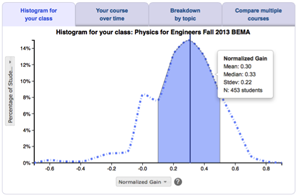SCALE-UP
What makes it unique?
How is SCALE-UP different from studio, tutorials, or other research-based teaching methods? SCALE-UP, like studio, is not a particular set of curricular materials, but a classroom structure that facilitates students working together. Many research-based teaching methods involve students working together in small groups. SCALE-UP created a model where these “best practices” (active and collaborative learning, etc.) could be used in large enrollment courses using the same resources as a traditional lecture course, partially by harnessing the power of technology. It can, and does, use adapted versions of other research-based materials.
One feature that differentiates SCALE-UP from other methods involving small group work is that students interact not only within their own small groups, but also with other groups, so that the entire classroom is a community where all the students are supporting each other. This inter-group interaction is facilitated through round tables with three groups of three students at each table, through activities that explicitly require students to interact with other groups, and through encouragement and instruction from the instructor. Because students are supporting each other through inter-group interaction and not just within their own groups, SCALE-UP can support much higher student/instructor ratios than other research-based teaching methods.
Many institutions adopting SCALE-UP have created their own names for their approach and/or classroom(s), so the same method is known by many names, including:




